Managing Medications: 7 Tips for Parents of Medically Complex Kids

This post may contain affiliate links; please see our terms of use for details.
When you have a child with complex medical issues chances are they are taking multiple medications. If your household is like most, then there’s also a pretty good chance there are other people (and maybe even pets!) who are also taking medications or supplements regularly.
All of those pills and medications can add up, leading to the possibility of mistakes, missed doses or even medication mix ups. Throw in multiple trips to the pharmacy and you’ve at least got a lot of stress on your hands!
How can you make managing medications easier?
1. Automate Whenever Possible
Most pharmacies allow you to place your prescriptions on auto refill. Do it! Even if you can’t pick up those meds right away, they will be there waiting for you when you can. You may think it’s better to control your time by calling in refills when you need them rather than letting an automated system make those decisions, but think of all the minutes you will save just in avoiding those long (and usually frustrating) calls with the voice recognition robot who asks you to repeat your Rx number five times!
Doctors’ offices generally don’t let you automate your request for a new prescription when your refills run out, but you can set reminders on your phone when you know a medication will need physician approval. And keep in mind that there are state and pharmacy regulations for controlled substances, giving you very little wiggle room when you need a new script sent in.
2. Use the Best Tools
Sometimes pills need to be cut or crushed or mixed before being dispensed. Make that all easier with the best cutters and crushers! If you need to split pills (large or small) I highly recommend the Equadose Pill Cutter. It has a very sharp blade and a pill stabilizer that keeps the pill in place while cutting. That’s key!
For pill crushing, I rely on a good old fashioned mortar and pestle. In my experience, pill crushers just make a mess and I worry that we lose some of the dosage in dust. A mortar and pestle does a great job and even looks kind of cool displayed on your kitchen counter. I learned from nurses at Boston Children’s Hospital that porcelain models produce the finest results and they are so right! I also prefer a mortar with a non-slip base.
My son takes his meds by mouth, but they need to be crushed and mixed in apple sauce for him to be able to eat them. I bought a set of small glass bowls to dispense our medications and mix them with applesauce. It also helps to have a bowl for each member of the family so everyone’s medications are kept separate. I like glass because they are easy to clean, but if glass makes you nervous, I also really like these small melamine plastic bowls.
3. Use Proven Hacks
Want to go a step beyond pill crushing? Or maybe you need to mix pills with liquid in order to put them through a g-tube. Did you know there is a hack for that?
Just place the pill in a syringe with water and pump the plunger a few times. The vacuum effect causes the pill to dissolve instantly! Watch this video for the how to:
@stefanavilaofficial Perfect for probe food ✌️#nurse #nursehack #probefood #fyp #foryoupage #sykepleier #nurselife #hospital ♬ Monkeys Spinning Monkeys – Kevin MacLeod & Kevin The Monkey
Or maybe your problem is that your child just can’t tolerate the taste of the medicine? I love this idea to turn medications into icing! If you are using pills instead of liquid meds, then dissolve your pills in water, add powdered sugar and wow! You have instant medicated icing!
@vgwschutte saw someone on here say mix with applesauce, but that didn’t work for us. here’s what did ❤️ #momhack #medicinehack #momtip #momadvice ♬ original sound – Virginia Schutte
Another awesome hack is to give your baby their medication through a bottle nipple. It works especially well if they are in the middle of a bottle feeding and you just quickly swap out the milk for medicine!
@linafrancesandfam #momhack #sickbaby #medicationadministration #momsoftiktok #momtricks #babybottle ♬ Howl’s Moving Castle – Merry-Go-Round of Life – Vitamin String Quartet
Honestly, if you are tackling a specific problem organizing or giving your medications to your child, there’s a pretty good chance a mom (or nurse) has already solved that problem! Ask in an online support group or just do some video searches and you will most likely find a good solution.
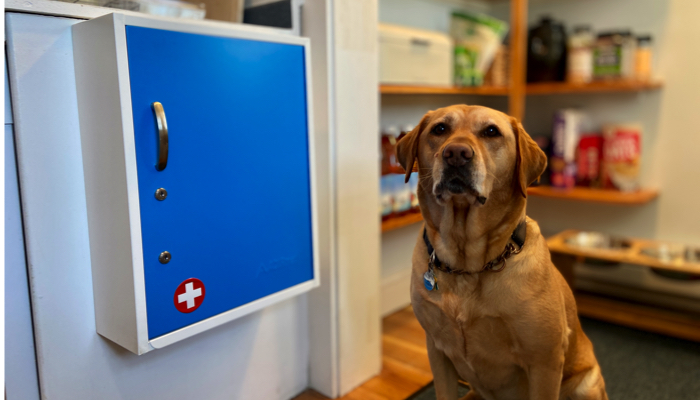
4. Organize Everything in One Safe Place
Keeping everything in one place is also a great way to manage both your time and your stress levels – And it can help you avoid mistakes too! I got a wall mounted security cabinet for our medications a few years ago and I still think it is one of my all time favorite purchases.
I keep it in the kitchen since I do most of my medication dispensing before meals and it’s a great way to keep things neat and in order. I also really appreciate that it locks to make sure that no one can get into the meds if they aren’t supposed to.
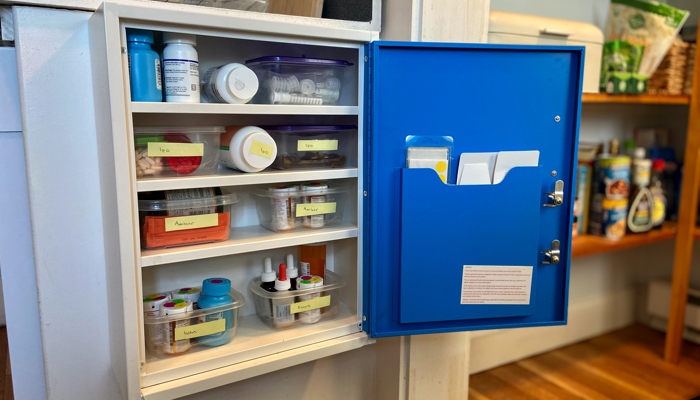
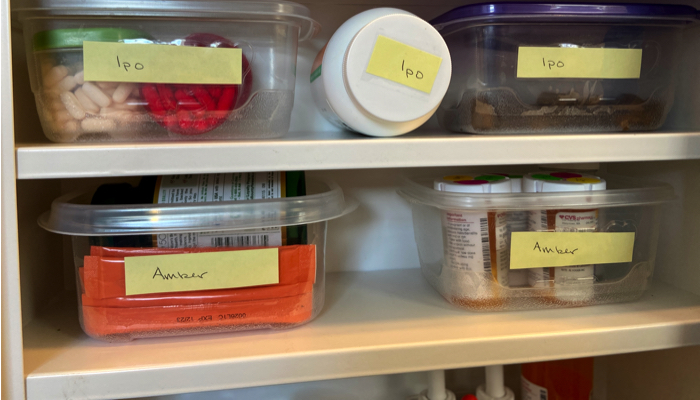
5. Label, Label, Label
In our house we have two adults, one child and one dog all taking regular medications. That can get confusing! I keep everyone’s medications in their own plastic containers and label each container with their name. When it’s time to prepare medications, I take out the containers one at a time and work on one person’s (or one dog’s) meds separately.
On each individual bottle I place small garage sale stickers that mark the pills by patient initials, abbreviated medication name and medication dose. Looking at the pills from above I can instantly see which meds I have and who they belong to.
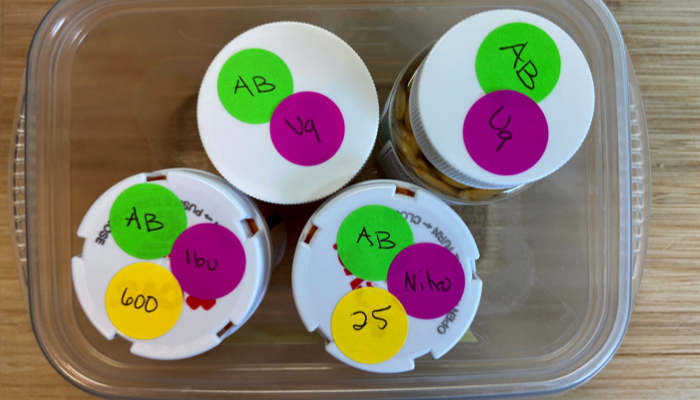
I know some people prefer to keep their meds in daily dosing pill boxes, but I don’t like to remove pills from their original bottles. With so many different medications to keep tabs on I’d hate to mix up a pill once it’s out of its bottle.
6. Keep a Cheat Sheet
Everyone in my household also has a printed medication cheat sheet – some people have much longer cheat sheets than others! On each sheet I list the medication name (both generic and name brand), the dose and the doctor who prescribes it along with their number for refill requests. Below that I have three spaces for AM, MID and PM doses where I note how many pills and milligrams are taken in the morning, midday and at night.
It looks something like this:
| [Med Name] 400mg | Prescribed by Dr. Smith (neuro) | Refills: (555) 555-5555 |
|---|---|---|
| AM | MID | PM |
| 4 (1600mg) | – | 4 (1600mg) |
I keep these sheets updated and stored in the medication cabinet. If I need a refresher on dosages, all the information is right there. Better yet, if I’m not available to put together the medication that day, the information isn’t locked in my head and someone else can manage the medications.
This sheet is also great to take with me to my son’s doctor appointments.
7. Keep Supplies in Stock
This tip is kind of a no-brainer, but it’s good to be reminded that a lot of the supplies you need are available for free at your pharmacy. Syringes, syringe adapters, disposable measuring cups, etc are all part of your medication prescription and it’s totally okay to ask for extras. Especially those syringe adapters – I have a collection of those because when you need one you need it now!

The information WonderBaby provides is not intended to be, and does not constitute, medical or other health advice or diagnosis and should not be used as such. Always consult with a qualified medical professional about your specific circumstances.
Related Posts

Special Needs
5 Spring Cleaning Tips for Families of Children with Disabilities
Spring cleaning is an opportunity to create a more accessible, organized, and supportive space for your child with disabilities. Declutter, deep clean, and refresh!

Visual Impairment
The Gift of Understanding: How a Young Child Helps His Blind Father Navigate Life
When a parent is blind, it’s natural for people to wonder how their sighted child will adapt. Will they struggle to understand their parent’s needs? Will they feel burdened by...
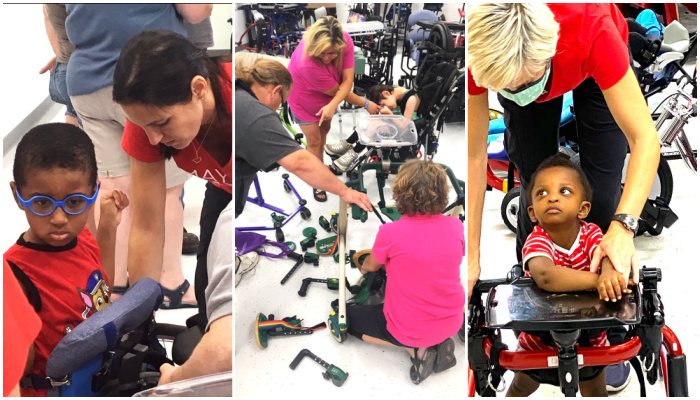
Assistive Technology, Support
May We Help: Engineering Independence for People with Disabilities
May We Help is dedicated to designing and building custom solutions that help individuals of all ages achieve mobility, access, and independence, all at no cost.